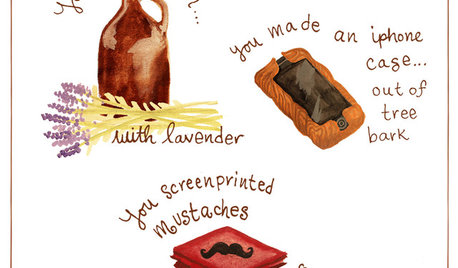another bug juice question
riley17
15 years ago
Related Stories

EXTERIORSCurb Appeal Feeling a Little Off? Some Questions to Consider
Color, scale, proportion, trim ... 14 things to think about if your exterior is bugging you
Full Story
THE HARDWORKING HOMEA Hidden Charging Cabinet Corrals and Juices Family’s Electronics
The Hardworking Home: Laptops, phones and tablets now have a safe space in this kitchen, keeping the countertops uncluttered
Full Story
GARDENING AND LANDSCAPINGBreezy and Bug-Free Modern Porches
Screening keeps pests out of these diverse porches across the U.S., while thoughtful designs keep them visually appealing
Full Story
GARDENING AND LANDSCAPINGBid Bad Garden Bugs Goodbye and Usher In the Good
Give ants their marching orders and send mosquitoes moseying, while creating a garden that draws pollinators and helpful eaters
Full Story
DIY PROJECTS12 Signs You've Caught the DIY Bug
Been making inventive things from scratch? Repurposing salvaged pieces creatively? It may be more serious than you think
Full Story
KITCHEN DESIGN9 Questions to Ask When Planning a Kitchen Pantry
Avoid blunders and get the storage space and layout you need by asking these questions before you begin
Full Story
GREEN BUILDINGConsidering Concrete Floors? 3 Green-Minded Questions to Ask
Learn what’s in your concrete and about sustainability to make a healthy choice for your home and the earth
Full Story
FEEL-GOOD HOMEThe Question That Can Make You Love Your Home More
Change your relationship with your house for the better by focusing on the answer to something designers often ask
Full Story

HOUSEKEEPINGDon't Touch Another Stain Before You Read This
Even an innocent swipe with water may cause permanent damage. Here's what to know about how rugs and fabrics react
Full Story






blutranes
dottyinduncan
Related Professionals
Holly Springs Landscape Architects & Landscape Designers · Beachwood Landscape Architects & Landscape Designers · Glen Ellyn Landscape Architects & Landscape Designers · Waterbury Landscape Contractors · Bethel Park Landscape Contractors · Concord Landscape Contractors · Cornelius Landscape Contractors · Oak Harbor Landscape Contractors · Pleasanton Landscape Contractors · Teaneck Landscape Contractors · Watertown Landscape Contractors · Chandler Decks, Patios & Outdoor Enclosures · Franconia Decks, Patios & Outdoor Enclosures · Lauderdale Lakes Decks, Patios & Outdoor Enclosures · Myrtle Beach Decks, Patios & Outdoor Enclosuresriley17Original Author
blutranes
citysoil
blutranes
pennymca
blutranes
riley17Original Author
milque_toast
blutranes
riley17Original Author
blutranes
riley17Original Author
stephe7
briergardener_gw